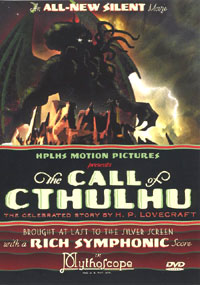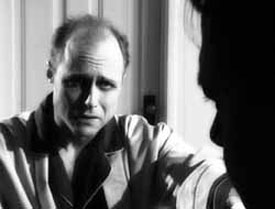 In its own small way, The Call of Cthulhu (2005) is a remarkable work of horror, adapted from the Lovecraft story to the silent screen borrowing much from German Expressionist cinema.
In its own small way, The Call of Cthulhu (2005) is a remarkable work of horror, adapted from the Lovecraft story to the silent screen borrowing much from German Expressionist cinema.
The original Lovecraft novella is "built up" from bits & scraps of unrelated materials that slowly reveal incredible forces at play. Lacking much in the way of a central protagonist, the original story is so unusual in its structure that it really couldn't be adapted to a typical horror movie in any way that would keep much of the original story.
And yet the creative team that made this film managed to keep the original structure more or less intact, as the minimalist-dialogue of the silent film format was much more conducive than a "talkie" could've been in presenting Lovecraft's original head-thinky story.
The resultant epic silent film in black & white incorporates old-fashioned special FX such as stop motion animation, & a minimum of modern CGI impositions so as to retain the vintage look of the piece.
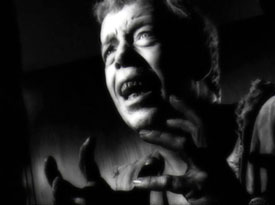 They do use a few computer FX as when they reconstruct a street in Providence, Rhode Island, to look like it did when Lovecraft first described the Fleur de lis building. They do use a few computer FX as when they reconstruct a street in Providence, Rhode Island, to look like it did when Lovecraft first described the Fleur de lis building.
Or when the Cthulhu cult is shown dancing insanely in the swamp, that swamp was actually a miniature, the dancers inserted via blue-screen work. But for the most part the creative team adhered to what was available to 1920s film makers.
It's not as perfect a modern duplication of silent cinema as was Claire (2001), but it has some of the same appeal.
The Call of Cthulhu is obviously adapted by fans who had a great respect for H. P. Lovecraft, besides a pretty firm knowledge of silent films. The sets are quite simple but like those in The Cabinet of Dr. Caligari (1920), they evoke beauty by leaning shapes & shadow & are ultimately a lot more beautiful than realistic sets would be.
Occasionally it looks way too cheap & campy, but mostly it's exceedingly hip, with its honest affection for Lovecraft lending a distinctive added charm.
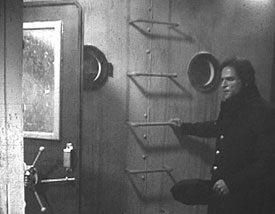 The actors in the piece might've been amateur if we'd heard them doing dialogue, but miming their roles, they come off as absolutely brilliant, making every scene impassioned & real. The actors in the piece might've been amateur if we'd heard them doing dialogue, but miming their roles, they come off as absolutely brilliant, making every scene impassioned & real.
But as with the original story, individual characters are not as important as the accumulative evidence of powers & divine monstrosities whose cosmic history dwarfs to insignificance the transient human rule of the Earth.
The story slowly unveils a weird mythology of the Old Ones from beyond the stars, & Great Cthulhu who sleeps in the depths of R'lyeh, a sunken land that will one day rise from the sea.
By the time truly bizarre events begin to occur in a context other than dreams & evil worship, we have some sense of the cosmic miasma & dread that hovers around the persistence of Cthulhu in our world, giving it more meaning than in a mere creature feature.
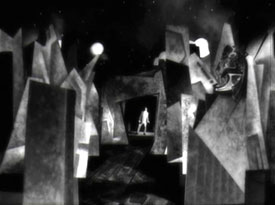 The sea journey to the place of R'lyeh is especially well developed. The discovery of the prehistoric ruins on an island where no charted island exists, the sailors' exploration of those ruins, is impressive micro-budget filmmaking & set design. The sea journey to the place of R'lyeh is especially well developed. The discovery of the prehistoric ruins on an island where no charted island exists, the sailors' exploration of those ruins, is impressive micro-budget filmmaking & set design.
The pay-off is the flight from Cthulhu, the squid-headed monster who slept at the bottom of the sea, & now is risen. Unfortunately the film gets cutesy at this point, & Cthulhu is rather too easy to get away from, given the creature's implied powers over mankind.
And unfortunately the stop-motion monstrosity is not well designed. Indeed, it is designed to look a lot like a rubber suit monster from a Japanese film, conforming to human body type with squid-head added.
Given that it's actually a small animated puppet & not a rubber suit, it should've been designed as much more a creature of aquatic depths, of a shape & form a lot less humanoid.
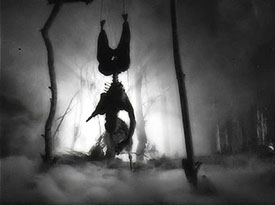 The climax is fun & the film as a whole a delight, but it might also have been just a little bit frightening with a better Cthulhu design, with perhaps a more toad-like body rather than fat-man body type. The climax is fun & the film as a whole a delight, but it might also have been just a little bit frightening with a better Cthulhu design, with perhaps a more toad-like body rather than fat-man body type.
The stop motion creature does have considerable appeal, but is at the same time totally hokey, when the lead-up to this conclusion had been so much more effectively moody & eerie in tone.
Even with its climaxing faults, it is the first film to take Lovecraft's original material seriously rather than jettison everything about his writing in favor of conventional B-cinema.
And if something like this adaptation had been around when I was a kid easily fooled by mediocre puppetry, it would probably have become one of the milestone viewings of my childhood. The adult eye can't help but be tossed out of the thing by the imperfections, but even at that, I loved it.
Continue to the obviously Cthulhu-inspired:
Deep Rising 1998
copyright © by Paghat the Ratgirl
|
